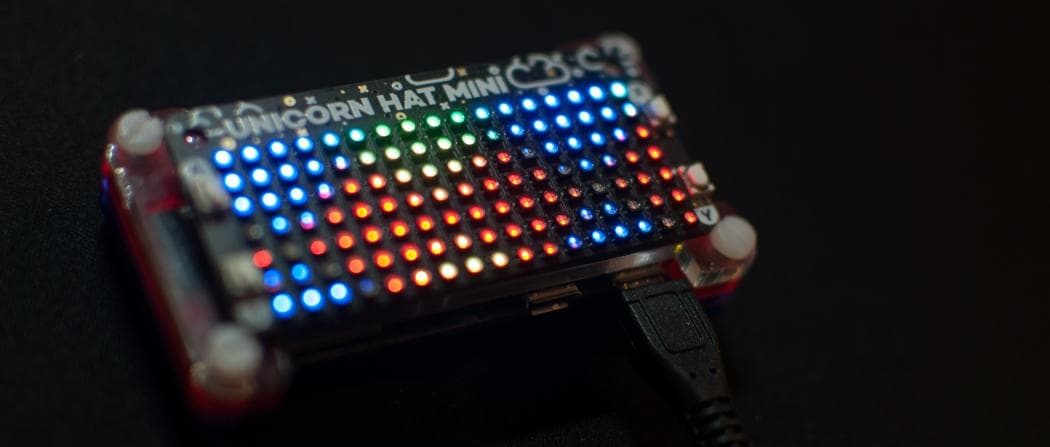A few months ago, I posted about wanting to Learn more Python
The best way I learn new things is by making something. If I can make something thats useful for me, even better !
So I decided to try and create a Raspberry Pi build Status light for this blog.
Required Items
- A Raspberry Pi (I am using a Raspberry Pi 2 Model B running Raspbian Stretch)
- A UnicornHatHd from Pimoroni
- A Gitlab account and a Repository. The Repository does not have to be Public. I use Gitlab as this Blogs Source Code Repository and have a CI/CD pipeline set up, so I wanted to also see what the api on Gitlab was like.
The GitLab Api
So I went straight to https://docs.gitlab.com/ee/api/api_resources.html
Looking around, I found the section on Pipelines
In order to use the Api, you need to know the Id of your Repository and set up a Token to allow you access.
Access tokens are configured in your Gitlab Account Settings. You can set a limit on the type of access and for how long.
The examples in the Gitlab Api Docs all use the CURL command line tool
so by passing
curl --header "PRIVATE-TOKEN: <your_access_token>" "https://gitlab.com/api/v4/projects/<your repo Id>/pipelines"on the command line, you should see a json response of your pipelines for the Repo.
Using Python
Using Curl is Ok for testing the api. But what about calling it from Python ?
A quick google led me to the very nice Requests Http Library
using Requests you can make a simple GET
res = requests.get(targetUrl, headers=headers)which returns an object you can manipulate.
so with with a little bit of work I created a Class in python that could call the Api to get the Pipeline Status from a Repo
import requests
import json
from string import Template
class GitLabPipeLine:
url = ""
token = ""
pipeLineUrl = Template('https://gitlab.com/api/v4/projects/$n1/pipelines')
def __init__(self, repoId, token):
self.repoId = repoId
self.token = token
self.url = self.pipeLineUrl.substitute(n1=self.repoId)
def GetLatestStatus(self):
headers = {'PRIVATE-TOKEN': self.token}
res = requests.get(self.url, headers=headers)
pipelines = json.loads(res.text)
pipeline = pipelines[0]
return pipeline['status']Leds... Shiney !
I took a demo example from the Pimoroni site for the UnicornHatHd and tweaked to suit my needs
class LedDisplay:
# default constructor
def __init__(self, messageTemplate):
unicornhathd.rotation(270)
unicornhathd.brightness(0.7)
self.Font = ('/usr/share/fonts/truetype/freefont/FreeSansBold.ttf', 12)
self.message = Template(messageTemplate)
def ShowSuccess(self):
colour = (0, 255, 0)
mess = self.message.substitute(n2="Successful")
self.displayText(mess, colour)
def ShowFailure(self):
colour = (255, 0, 0)
mess = self.message.substitute(n2="UnSuccessful")
self.displayText(mess, colour)The first section sets up some methods to be called by the main.py script
The rest of the code renders the message to UnicornHatHd
def displayText(self, message, msgColour):
width, height = unicornhathd.get_shape()
text_x = width
text_y = 2
font_file, font_size = self.FONT
font = ImageFont.truetype(font_file, font_size)
text_width, text_height = width, 0
try:
w, h = font.getsize(message)
text_width += w + width
text_height = max(text_height, h)
text_width += width + text_x + 1
image = Image.new('RGB', (text_width, max(16, text_height)), (0, 0, 0))
draw = ImageDraw.Draw(image)
offset_left = 0
draw.text((text_x + offset_left, text_y), message,
fill=(msgColour[0], msgColour[1], msgColour[2], 255), font=font)
offset_left += font.getsize(message)[0] + width
for scroll in range(text_width - width):
for x in range(width):
for y in range(height):
pixel = image.getpixel((x + scroll, y))
r, g, b = [int(n) for n in pixel]
unicornhathd.set_pixel(width - 1 - x, y, r, g, b)
unicornhathd.show()
time.sleep(0.03)
except KeyboardInterrupt:
unicornhathd.off()
finally:
unicornhathd.off()so all that is left to do is
Sudo Python main.pyTa Da !!!

Apologies for the mobile phone camera shake 😏
Hopefully you can see how fairly simple it is to build your own Build Status Light with a Raspberry Pi
Options to extend the code could be :-
- Make the code work with a Github repo
- Make the code work with other devices or a simple LED
- Add more animations for the UnicornHatHd
You can see the source code on my Gitlab
References
https://github.com/pimoroni/unicorn-hat-hd
